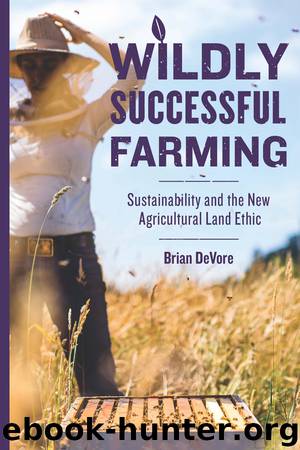Wildly Successful Farming by Brian DeVore

Author:Brian DeVore
Language: eng
Format: epub
ISBN: 9780299318888
Publisher: University of Wisconsin Press
Unearthing Economics
Maybe those later adopters are being reached, but as Greene County’s hybrid corn example shows, awareness does not guarantee full acceptance. Fisher said the majority of farmers agree a practice like cover cropping makes conservation sense, but it also has to pencil out financially. That’s why the hub farmers were chosen not only for innovative attitudes toward soil management, but also for their ability to track financials and willingness to talk about them. Dan DeSutter, the west-central Indiana farmer, fits the role perfectly. In a sense, farmers like DeSutter serve as an important link in a chain that extends from the ecologically minded motivations of someone like Werling to the more economically centered drivers on Indiana’s larger operations. A former financial analyst and commodities broker, he knows how to track trends, talk numbers, and sniff out inefficiencies.
One day while standing in a trench fixing a tile drainage line, DeSutter noticed that roots from the rye cover crop a Purdue University researcher was studying on his family’s farm were boring at least four feet deep into the soil. Such “bio-drilling” was impressive, given that over the years the DeSutters had been putting a lot of effort into using a mechanical ripper to break up compaction. Ripping requires a tractor with lots of horsepower and burns lots of fuel.
“That was my aha moment,” DeSutter told me. “We were spending all this money on ripping when for a few dollars per acre worth of seed, this plant would be doing it for us. You tell me what’s going to do it better: the plant or the steel?”
To DeSutter, that was the “physical” economic argument for building soil health. As he has gotten deeper into cover cropping and talked to other leaders in the field (he traveled to Australia one winter as an Eisenhower Fellow to study soil health building techniques there) DeSutter has also been convinced about the “biological” benefits. Namely, the conventional system of growing corn or soybeans, which covers the land only a few months out of the year with living plants, is actually very inefficient at utilizing all the free sunlight above ground and biological activity below ground.
DeSutter provided a mini soil economics lesson while giving a presentation in the machine shed at Moody Farms. He explained to the gathered farmers that he has doubled his organic matter to 4 percent on many of his acres; as I describe in chapter 5, organic matter is a key element of healthy, biologically active soil. DeSutter then went into a simple calculation showing that the nitrogen he is gaining from this increased organic matter is basically a source of fertility he doesn’t have to purchase. “That’s like a forty dollar per acre annuity that keeps paying us,” he said at one point as the seated farmers took notes.
DeSutter also pointed out that 1 percent of organic matter in the top twelve inches of the soil profile is worth an inch of water storage. “How much is a two-inch rain worth in August?” he asked, following up with an answer in the form of more math.
Download
This site does not store any files on its server. We only index and link to content provided by other sites. Please contact the content providers to delete copyright contents if any and email us, we'll remove relevant links or contents immediately.
The Lonely City by Olivia Laing(4568)
Animal Frequency by Melissa Alvarez(4150)
All Creatures Great and Small by James Herriot(3986)
Walking by Henry David Thoreau(3681)
Exit West by Mohsin Hamid(3634)
Origin Story: A Big History of Everything by David Christian(3472)
COSMOS by Carl Sagan(3347)
How to Read Water: Clues and Patterns from Puddles to the Sea (Natural Navigation) by Tristan Gooley(3240)
Hedgerow by John Wright(3106)
How to Do Nothing by Jenny Odell(3102)
The Inner Life of Animals by Peter Wohlleben(3099)
How to Read Nature by Tristan Gooley(3078)
Project Animal Farm: An Accidental Journey into the Secret World of Farming and the Truth About Our Food by Sonia Faruqi(3018)
Origin Story by David Christian(2991)
Water by Ian Miller(2952)
A Forest Journey by John Perlin(2915)
The Plant Messiah by Carlos Magdalena(2745)
A Wilder Time by William E. Glassley(2690)
Forests: A Very Short Introduction by Jaboury Ghazoul(2671)
